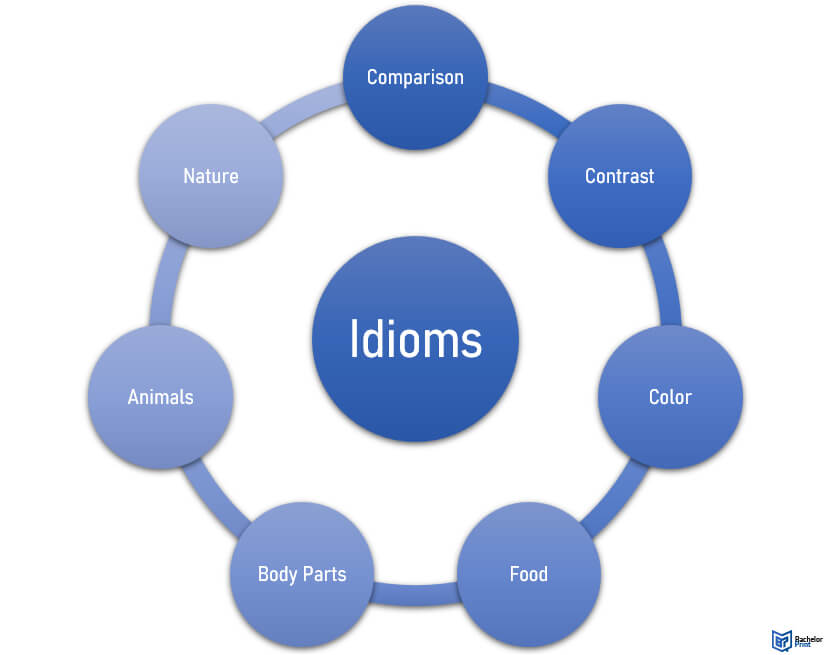
Sayings enrich our language, adding depth, color, and texture to our communication. They are the threads that weave together our cultural fabric, offering insights into our collective psyche and values. One of those sayings is called an idiom. They’re a phrase or expression whose meaning cannot be understood from its literal interpretation. In this article, you will find more information on its definition, various examples, their distinct meaning, and common misunderstandings that can occur.
Definition: Idiom
The word idiom comes from the Greek word “idiōma,” which means “peculiar phraseology.” In linguistics, phraseology is the study of expressions that belong to a specific language, field, or community.
Over time, the term evolved to refer to the unique way of speaking or the characteristic language of a specific group of people, and eventually to the more specific linguistic sense in current usage: a phrase or expression that has a figurative meaning different from its literal meaning. This evolution reflects the concept of cross-language idioms as expressions that are ‘owned’ or particular to a certain language or group of people.
To help you obtain a better comprehension of idioms, here are some common examples of English idioms.
These examples illustrate different typical examples of idioms in the English language. As you can see, they include an underlying meaning and can’t be understood by their literal meaning.
- ✓ Free express delivery
- ✓ Individual embossing
- ✓ Selection of high-quality bindings
Types
Idiomatic expressions can be categorized into various types based on their idiomatic meanings and the ways they express ideas. Here are some different types with examples and their actual meanings.
These English idioms use comparison to describe one thing in terms of another, often employing similes with figurative meanings.
This category of idioms highlights a contrast between two things or ideas.
This type of idiom uses colors to convey figurative meanings or emotions.
Culinary idioms that incorporate food items to convey meanings unrelated to the food itself.
These idiomatic expressions involve parts of the body to describe feelings, actions, or situations.
Examples of these types of figurative idioms include animals, to express ideas about human behavior or specific characteristics.
Figurative idioms drawing from elements of nature to illustrate concepts or situations.

Effects
The use of idioms in language has several significant effects, both on communication and on the listener or reader’s perception. Here are some of the key impacts.
1. Cultural Connection
Idiomatic expressions often carry cultural significance and historical context, making their use a way to connect with a particular cultural identity or heritage. They can provide insight into the values, attitudes, and experiences of a community.
Using idioms specific to a region or country can foster a sense of belonging or shared understanding among speakers of the same cultural background.
2. Enhanced Expressiveness
They add color and vividness to language, allowing speakers to express ideas in a more engaging and imaginative way. They can convey complex emotions or situations succinctly, making communication more interesting, lively, and dynamic.
3. Increased Informality
Their use tends to make language more informal and conversational. This can help break down barriers between speakers, creating a more relaxed and friendly atmosphere.
4. Potential for Misunderstanding
For non-native speakers or those unfamiliar with the cultural context, idioms can be confusing and lead to misunderstandings. The figurative meaning of idioms is not always obvious, which can complicate communication in diverse settings.
5. Creativity in Language
Idiomatic expressions encourage creativity in both speech and writing. They challenge speakers and writers to think beyond literal meanings and explore more figurative, imaginative ways of expressing themselves.
Writers often make use of idioms to craft more compelling narratives or dialogue that resonates with readers on an emotional level.
6. Cognitive Development
Learning and understanding idioms can aid in cognitive development, especially in language acquisition. It requires understanding context, figurative language, and nuances of meaning, which can enhance problem-solving and critical thinking skills.
7. Social Inclusion or Exclusion
The appropriate use of idioms can signal social inclusion or membership within a particular linguistic or cultural group. Conversely, misuse or lack of understanding can highlight an outsider status, leading to exclusion.
Examples
In a previous paragraph, we have already gotten to know some common examples in the English language. Now we can use them in sentences of various fields and interests.
Here are some examples on how you can use idiomatic expressions in everyday life.
Some professional examples that can be used in the workplace can be seen below.
English idioms can also vary depending on the region you’re living in.
Here are some examples that started their origin from literature.
English idioms are also used in the context of shows, movies, theater, backstage and on television.
Musical idioms can often be found in songs once you look for them.
There are plenty of idioms that are fun to learn for English language learners, and especially for kids.
International Examples
Sayings and idioms are deeply rooted in the cultural and linguistic context of their origin, making them particularly challenging to translate. Here are examples from other countries.
English idioms
Some examples of English-language idioms in other countries can be seen below.
| Origin | Idiom | Meaning |
| Australia | Fair dinkum. | Are you being honest with me? |
| United Kingdom | Bob's your uncle. | There you go. |
| Canada | To give'er. | Putting in a great effort. |
Cross-language idioms
Idiomatic expressions often contain cultural references that lose their meaning or impact when translated. Cultural elements specific to one society may not resonate or even exist in another, making a direct translation of idioms not just challenging but sometimes impossible without additional explanation. The following table shows some cross-language idioms.
| Origin | Idiom | Literal Translation | Meaning |
| French | Tomber dans les pommes. | To fall in the apples. | To pass out. |
| Spanish | Estar en las nubes. | To be in the clouds. | Head in the clouds. |
| Ireland | The craic was ninety | The fun was ninety. | Extremely enjoyable. |
| German | Ich glaube mein Schwein pfeift! | I think my pig is whistling! | I can't believe it! |
| Tagalog | Balat sibuyas. | Onion skin. | A sensitive person. |
| Afrikanist | (Ag,) Shame! | Oh, pity! | Cute, pity, admiration. |
| Hindi | Choodiyan todna. | Breaking bangles. | Significant grief or distress. |
Challenges of idioms
The use of idiomatic expressions can bring numerous challenges. Here are some of the main problems.
Bridging and Dividing
While sayings and idioms can bridge cultural and linguistic gaps by providing insight into the shared human experience, they can also divide. For those not privy to the cultural knowledge that sayings and common idioms encapsulate, these expressions can be puzzling, highlighting the insider-outsider dichotomy.
This underscores the importance of context and cultural literacy in communication, as understanding the underlying meanings of these phrases can significantly enhance cross-cultural understanding and dialogue.
Non-literal translation
An idiomatic meaning cannot usually be inferred from the literal meanings of its individual words. This non-literal nature requires learners to memorize cross-language idioms as whole units of meaning, rather than understanding them through translation or direct interpretation.
Translators must find creative ways to convey the intended meaning without losing the idiomatic expression’s cultural richness or emotional impact, which is quite a challenge.
Learning and Teaching
For educators and language learners, idioms represent a significant hurdle. They need to be taught as cultural and linguistic units, requiring learners to engage with the language beyond grammatical and vocabulary studies. This can add complexity to language education, and make the job of an English-speaker considerably difficult.
Differences between other sayings
In this paragraph, you will find various figures of speech or literary devices that can be similar to idioms. Yet, they have slight differences that have to be known.
Cliché
A cliché is an overused expression that has lost its originality and impact due to excessive use. Clichés can be a frequent idiom, but an idiom is not always a cliché because while it may have been striking or novel at one point, it has become predictable and unoriginal overtime.
Proverb
A proverb is a short, well-known saying that expresses a general truth, wisdom, or advice. They’re often culturally specific and passed down through generations. It can be similar to a typical idiom due to their non-literal translation, but also different because it’s used as advice.
Hyperbole
A hyperbole is a figure of speech that involves exaggerated statements or claims not meant to be taken literally. They are used to emphasizing or dramatizing.
Metaphor
A metaphor is a figure of speech often included in sayings or phrases that implies a comparison between two unrelated things by stating one thing is another.
FAQs
An example of a typical idiom is “Stop beating around the bush.” The idiomatic meaning of this phrase is that someone is avoiding saying something, so you’re asking them to get to the point.
An idiom is a figurative phrase, that has a non-literal meaning. They are specific to a particular language or culture.
It is a phrase that is normal to fluent speakers but strange to others because the words have a different meaning to what they say.
Determining the “most popular” one can vary significantly based on cultural context, language, and even the specific criteria used for measuring popularity. An example for a widely recognized one is:
- “Piece of cake,” which means something very easy to accomplish.
“It’s raining cats and dogs” is used to describe a very heavy, torrential downpour. The phrase does not mean that animals are falling from the sky, but rather uses exaggerated imagery to convey the intensity of the rainstorm.
